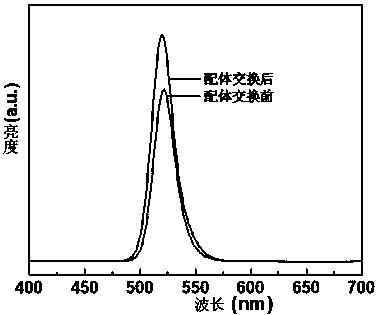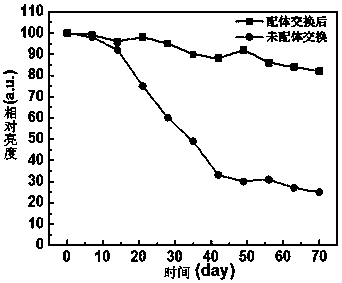Preparation method of quantum dots using deprotonated carboxylic acid as surface ligand
A surface ligand and proton removal technology, applied in the field of quantum dots, can solve the problems of poor stability of quantum dot colloid solution and weak binding of ligands, and achieve the effects of fast reaction rate, high luminous efficiency, and strong binding.
- Summary
- Abstract
- Description
- Claims
- Application Information
AI Technical Summary
Problems solved by technology
Method used
Image
Examples
Embodiment 1
[0044] 1. Preparation of quantum dots whose ligand is trioctylphosphine:
[0045] 1) Preparation of cadmium-zinc oleate precursor solution: Take 0.8mmol CdO, 8mmol zinc acetate, 15 ml oleic acid and 20 ml 1-octadecene in a 100mL three-necked flask, heat to 150°C under Ar atmosphere and exhaust for 1h. Form a transparent cadmium-zinc oleate precursor solution;
[0046] 2) Preparation of trioctylphosphine selenide-trioctylphosphine sulfide precursor: Dissolve 0.2 mmol of Selenium powder and 0.6 mmol of sulfur powder in 2 mL of Trioctylphosphine , to obtain trioctylphosphine selenide-trioctylphosphine sulfide precursor;
[0047] 3) Slowly heat the cadmium-zinc oleate precursor solution to 300°C, inject trioctylphosphine selenide-trioctylphosphine sulfide precursor quickly once, and keep the reaction for 8 minutes. Then lower the temperature to 100°C, add ethyl acetate to wash, and centrifuge to obtain a precipitate; then add chloroform and acetone and repeat centrifugation twic...
Embodiment 2
[0055] 1. Preparation of quantum dots whose ligand is tributylphosphine:
[0056] 1) Preparation of cadmium-zinc oleate precursor solution: Take 0.8mmol CdO, 8mmol zinc acetate, 15 ml oleic acid and 20 ml 1-octadecene in a 100mL three-necked flask, heat to 150°C under Ar atmosphere and exhaust for 1h. Form a transparent cadmium-zinc oleate precursor solution;
[0057] 2) Preparation of tributylphosphine selenide-tributylphosphine sulfide precursor: Dissolve 0.2 mmol Selenium powder and 0.6 mmol Sulfur powder in 2 mL of Trioctylphosphine , to obtain tributylphosphine selenide-tributylphosphine sulfide precursor;
[0058] 3) Slowly heat the cadmium-zinc oleate precursor solution to 300°C, inject tributylphosphine selenide-tributylphosphine sulfide precursor quickly once, and keep the reaction for 8 minutes. Then lower the temperature to 100°C, add ethyl acetate to wash, and centrifuge to obtain a precipitate; then add chloroform and acetone and centrifuge repeatedly twice to o...
PUM
 Login to View More
Login to View More Abstract
Description
Claims
Application Information
 Login to View More
Login to View More - R&D
- Intellectual Property
- Life Sciences
- Materials
- Tech Scout
- Unparalleled Data Quality
- Higher Quality Content
- 60% Fewer Hallucinations
Browse by: Latest US Patents, China's latest patents, Technical Efficacy Thesaurus, Application Domain, Technology Topic, Popular Technical Reports.
© 2025 PatSnap. All rights reserved.Legal|Privacy policy|Modern Slavery Act Transparency Statement|Sitemap|About US| Contact US: help@patsnap.com



